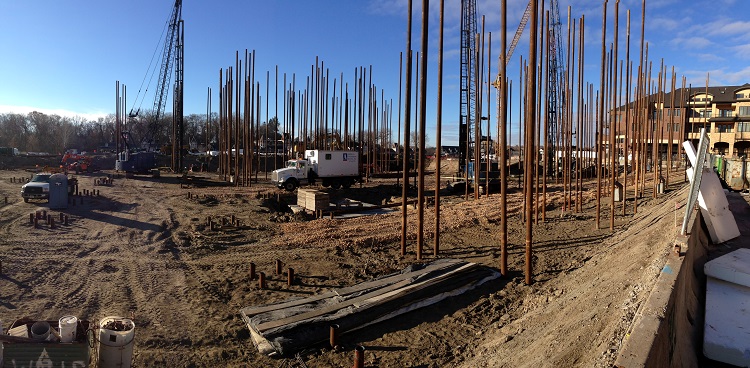Sometimes it’s wise to conduct a test pile program prior to the design of the foundation….

AET rig performing SCPTu testing for evaluating soil setup during pile driving.
Deep foundations require the use of piles, which are structural elements made of steel, reinforced concrete, or wood that penetrate deep into the ground to transfer building loads through poor soils into more competent soils or bedrock below.
When a project requires a pile-supported foundation, the piles must always be tested on site to confirm the load they can safely support, given soil conditions and other factors. On most projects, this activity takes place immediately before construction begins, in what is known as a “pre-construction” test pile program. Then, during construction, “production piles” are installed and become part of the permanent foundation. On some projects, however, it may make more sense to conduct a test pile program much earlier in the project — prior to the design of the foundation.
WHAT HAPPENS DURING A PRE-CONSTRUCTION TEST PILE PROGRAM?
Typically, the project’s geotechnical engineer makes foundation recommendations by estimating the pile capacity and the depth needed, based on soil boring results. Then, during the pre-construction test pile program, some piles are driven into the ground and the geotechnical engineer confirms previously estimated pile capacities, as well as determines the actual depths to which the piles must be driven to achieve these capacities. In some cases, the project team must adjust the pile lengths or drive piles to deeper-than-planned depths, which can bring unexpected costs to the project.
HOW IS A PRE-DESIGN TEST PILE PROGRAM DIFFERENT?
Because a pre-design test pile program increases a project’s upfront cost, it may not be suitable for every project. But for large piling projects or those involving variable soils it can provide valuable benefits. A pre-design test pile program can minimize the number of piles required and also minimize costly last-minute adjustments because test piles are driven on site to determine actual pile capacities before the foundation plans have been prepared. The structural engineer then uses this information to design the foundation. Although additional pile testing can occur during construction to account for soil variability, significant adjustments can be far less likely.
COST SAVINGS
Knowing how much capacity piles can achieve, and at what depths, allows for a more accurate foundation design, which can translate to cost savings. This proved true on the recently completed Promenade of Wayzata development, for which AET served as the geotechnical, environmental, and construction testing consultant.
Based on the owner’s conceptual designs and our geotechnical investigations, we performed a pre-design test pile program that consisted of driving two different diameters of steel pipe piles to three different depths in three different areas of the site (18 test piles total).
A pile’s capacity typically increases over time as the soils settle and consolidate around it, in a process known as “soil set-up.” To account for this, we tested each pile’s capacity during initial driving as it was installed into the ground, as well as during restrike at various time intervals over the course of 30 days. With this data, the design team based the project’s foundation designs on the higher (i.e., long-term) 30-day capacity of the piles, thereby optimizing the foundation design and also reducing the total footage of piling required. This resulted in a significant cost savings.
RESOURCE SAVINGS
By refining the number and/or lengths of piles needed prior to design, it’s possible to pare down the total amount of piling needed. This is arguably a measure of sustainability by saving raw materials such as steel and concrete (in the case of concrete piles or concrete-filled steel piles), as well as savings of one of a project’s more valuable resources: time. Reducing the length or number of piles required to be driven on a site can also lead to a shortened duration of construction.
COULD YOUR PROJECT BENEFIT?
As mentioned, a pre-design test pile program is best suited for large projects where the cost of the service is balanced by the potential cost savings of starting construction with an optimized pile design plan. If you’d like to take a more proactive approach on your next foundation project, please don’t hesitate to contact us. We can discuss options and see if your project could benefit.
Gregory Reuter, PE, PG, D.GE, is vice president of geotechnical engineering at AET.
He can be reached at greuter@amengtest.com

